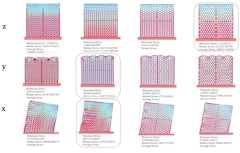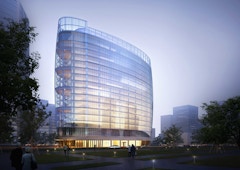
736 results
-
 As awareness around the seismic performance of buildings grows, it is becoming increasingly necessary to integrate seismic expansion joint cover…
As awareness around the seismic performance of buildings grows, it is becoming increasingly necessary to integrate seismic expansion joint cover… -

WRNS Studio
- Organization
WRNS Studio is an architecture and planning firm that provides high quality sustainable design.
-

Vitro Architectural Glass
- Organization
Vitro Architectural Glass, part of Vitro, North America’s largest glass producer, is exclusively dedicated to glass innovation and fueled by the same people, plants and products that made PPG Glass one of the industry’s most respected and reliable commercial glass manufacturers.
-

seele
- Organization
The seele group, with headquarters in Gersthofen in Bavaria, is one of the world’s top companies specializing in the design and construction of facades and complex building envelopes made from glass, steel, aluminum, membranes and other high-tech materials.
-

Permasteelisa Group
- Organization
Permasteelisa Group is a worldwide leading contractor, specialized in the engineering, project management, manufacturing, and installation of architectural envelopes and interior systems.
-

-
Lawrence Berkeley National Lab
- Organization
From the infinite scale of the universe to the infinitesimal scale of subatomic particles, researchers at Lawrence Berkeley National Laboratory – Berkeley Lab – are advancing the scope of human knowledge and seeking science solutions to some of the greatest problems facing humankind.
-

-

-

Invert Auto-Shading
- Paper by Jae Yong Suk, Assistant Professor Doris Sung, Associate Professor
Allowing sufficient amount of natural light while avoiding excessive sunlight penetration is often hard to achieve with static facade systems due to… -

Realizing Bespoke Structural Glass Facades
- Paper by Ned Kirschbaum, FAIA, CCCA, LEED AP, kirschbaum@fentressarchitects.com Peter Koukos, Director of Strategic Process Alfonso Lopez, P.E., Principal and CEO
In the very earliest stages of a design, an architect imagines a unique glazed facade form and wonders, “Is this possible?” and “What will it cost?”… -

Transfer Topologies
- Paper by Nada Tarkhan
This research looks at the relationship of material and geometric distribution to set a methodology for integrating structural and thermal design.
-

Determining the Optimal Opening for Multi Skin Facade with External Ventilation
- Paper by Peter Simmonds
The envelope of the Harbin Bank Building in Beijing has a Multi-Skin Facade where the outer cavity is naturally ventilated. During the design the
-

Put Your Sweater On!
- Paper by Eric Haas, AIA, LEED AP BD+C
During the particularly cold first months of 1977 President Jimmy Carter, in what some call “The Sweater Speech,” famously noted how much energy
-

Paper Reviewers Needed for the 2020 World Congress
- Announcement
Want to get more involved in Facade Tectonics Institute (FTI)? We are looking for volunteers to serve as paper reviewers for Facade Tectonics 2020 World Congress. If you would like to be a paper reviewer, please continue reading the instructions below.
-

FTI Extends Abstract Submission Deadline: Topics are Unconstrained!
- Announcement
The Facade Tectonics Institute announces an extension to the abstract submission period for the call for papers for its 2020 World Congress (FTI WC2020) to be convened in Los Angeles on March 25-26. A significant number of inquiries indicated a perception that paper topics were limited to those
-

Call for Posters: Facade Tectonics 2020 World Congress
- Announcement
We are pleased to announce that for the first time, the Facade Tectonics Institute will include a poster presentation at their 2020 World Congress. The poster presentation will serve as a graphic representation of each poster author's research and findings.
-

Call for Papers: Facade Tectonics 2020 World Congress
- Announcement
We are at a critical moment in the evolution of the built environment. In the face of multiple challenges confronting civilization, the transition to sustainable buildings and urban habitat is happening far too slowly and inefficiently. Central to achieving this transition is the facade system
-

Call for Papers: Facade Tectonics 2016 World Congress
- Announcement
The Facade Tectonics Institute has issued a call for papers for its 2016 Annual Conference and inaugural World Congress, which will include speaking and poster presentations, panel discussions, workshops and exhibitors.
-

2019 Request for Research concept Briefs
- Announcement
The FTI Research Committee is requesting Research Concept Briefs describing a team and approach for evaluating industry needs and challenges surrounding four key topic areas in which FTI has identified a need to accelerate innovation. The proposed research will clearly identify knowledge gaps and ba